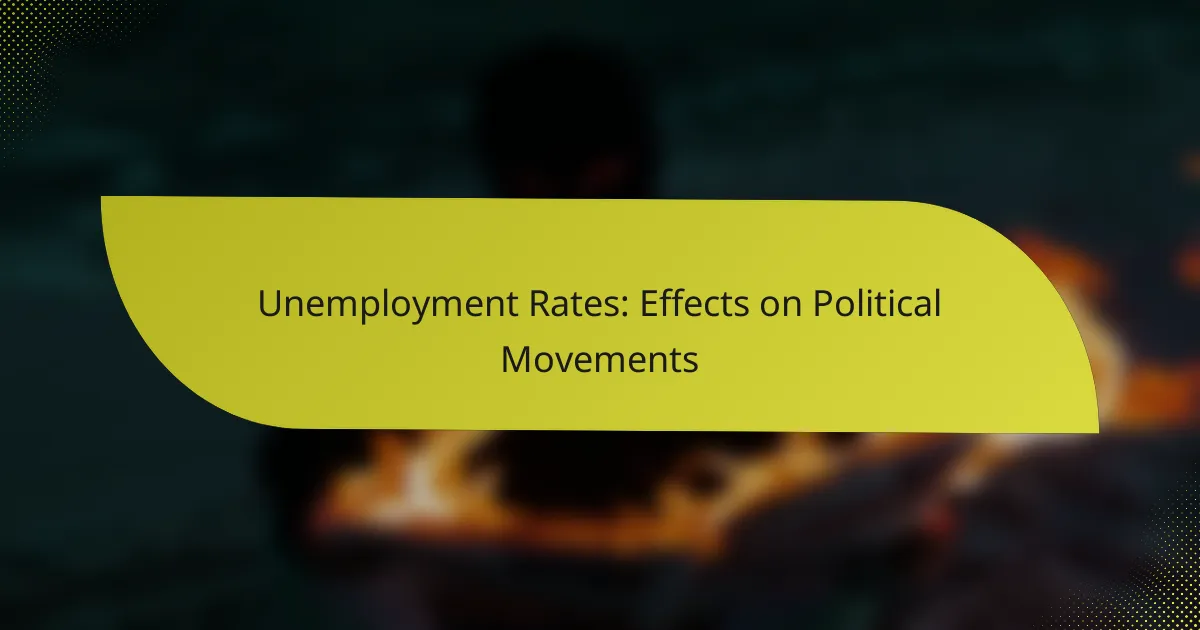Unemployment rates play a crucial role in shaping political movements by influencing public sentiment and collective action. When unemployment is high, dissatisfaction with existing political structures often rises, leading citizens to pursue change through activism and support for alternative candidates. This economic distress can mobilize individuals, prompting demands for policy reform and new leadership, ultimately altering voter behavior and preferences.
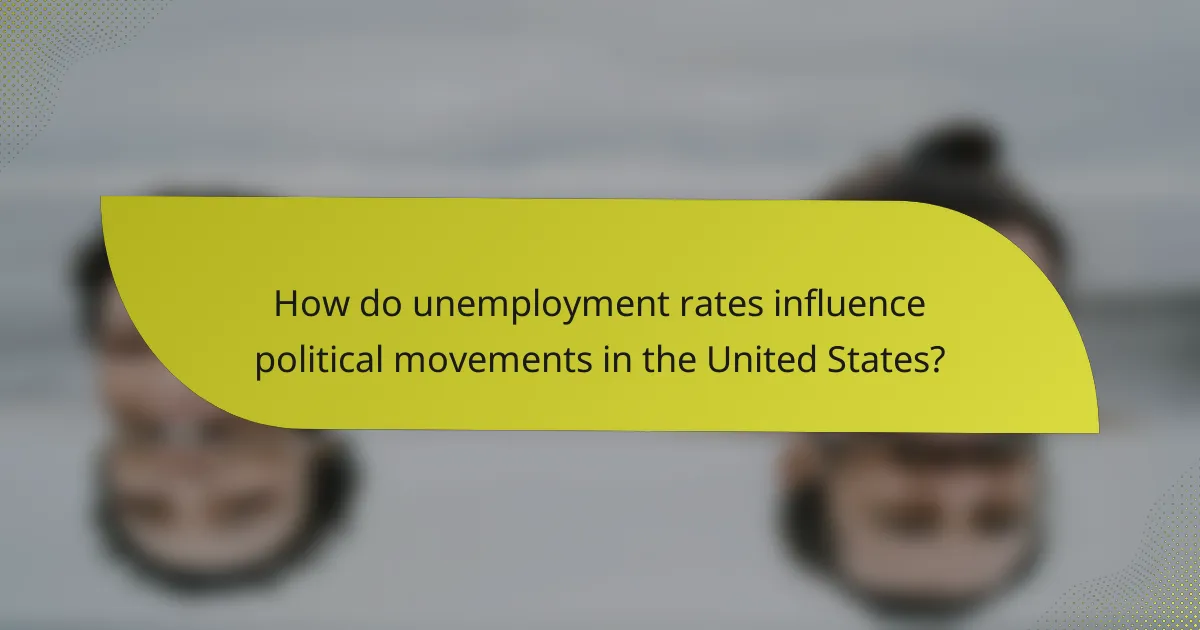
How do unemployment rates influence political movements in the United States?
Unemployment rates significantly impact political movements in the United States by shaping public sentiment and driving collective action. High unemployment often leads to increased dissatisfaction with the status quo, prompting citizens to seek change through activism and support for alternative political candidates.
Increased activism during economic downturns
Economic downturns typically trigger heightened activism as individuals and groups respond to job losses and financial insecurity. Movements advocating for workers’ rights, social safety nets, and economic reforms often gain momentum during these times, as people unite to demand government intervention and support.
For example, during the Great Recession, various grassroots organizations emerged, pushing for policies like increased minimum wage and expanded unemployment benefits. This activism can lead to significant political pressure on elected officials to address economic issues directly.
Shift towards populist candidates
High unemployment rates can lead voters to gravitate towards populist candidates who promise to prioritize the needs of the working class. These candidates often capitalize on economic discontent, presenting themselves as outsiders who will challenge established political norms and advocate for the average citizen.
In recent elections, populist figures have gained traction by focusing on job creation, trade policies, and economic justice, resonating with those who feel left behind by traditional political parties. This shift can reshape party platforms and influence the overall political landscape as mainstream candidates adjust their messages to appeal to disaffected voters.

What are the historical examples of unemployment affecting political change?
Unemployment has historically catalyzed significant political change, often leading to widespread social movements and reforms. Economic distress can mobilize citizens, prompting demands for policy shifts and new leadership.
The Great Depression and the New Deal
The Great Depression of the 1930s saw unemployment rates soar, with estimates reaching around 25% in the United States at its peak. This economic crisis led to widespread discontent and the rise of political movements advocating for change.
In response, President Franklin D. Roosevelt introduced the New Deal, a series of programs aimed at economic recovery and job creation. These initiatives not only addressed unemployment but also reshaped the role of government in the economy, establishing a precedent for federal intervention in times of crisis.
Post-2008 financial crisis protests
The financial crisis of 2008 resulted in significant job losses, with unemployment rates peaking around 10% in the U.S. This economic turmoil sparked protests and movements such as Occupy Wall Street, which highlighted issues of economic inequality and corporate influence in politics.
These protests reflected a growing frustration with the political establishment and led to increased public discourse on economic reform. The aftermath saw a shift in political priorities, with many advocating for policies aimed at reducing unemployment and regulating financial institutions.

What are the effects of rising unemployment on voter behavior?
Rising unemployment significantly influences voter behavior by increasing engagement among those who feel marginalized and altering their political preferences. Economic distress often drives individuals to seek alternatives to the mainstream parties, reflecting their dissatisfaction with the current political landscape.
Higher turnout among disenfranchised groups
As unemployment rises, disenfranchised groups, including low-income individuals and minorities, tend to increase their voter turnout. This demographic often feels the brunt of economic downturns, motivating them to participate in elections to advocate for change.
For example, during economic crises, voter turnout in areas with high unemployment can rise by several percentage points compared to previous elections. This shift highlights the urgency these groups feel in addressing their economic concerns through political action.
Increased support for third-party candidates
Rising unemployment can lead to a surge in support for third-party candidates, as disillusioned voters seek alternatives to traditional parties that they believe have failed to address their needs. These candidates often capitalize on the frustrations of the electorate by proposing innovative solutions to economic issues.
In recent elections, third-party candidates have gained traction in regions with high unemployment, often receiving double-digit percentages of the vote. This trend indicates a growing willingness among voters to explore non-establishment options when their economic situations are dire.
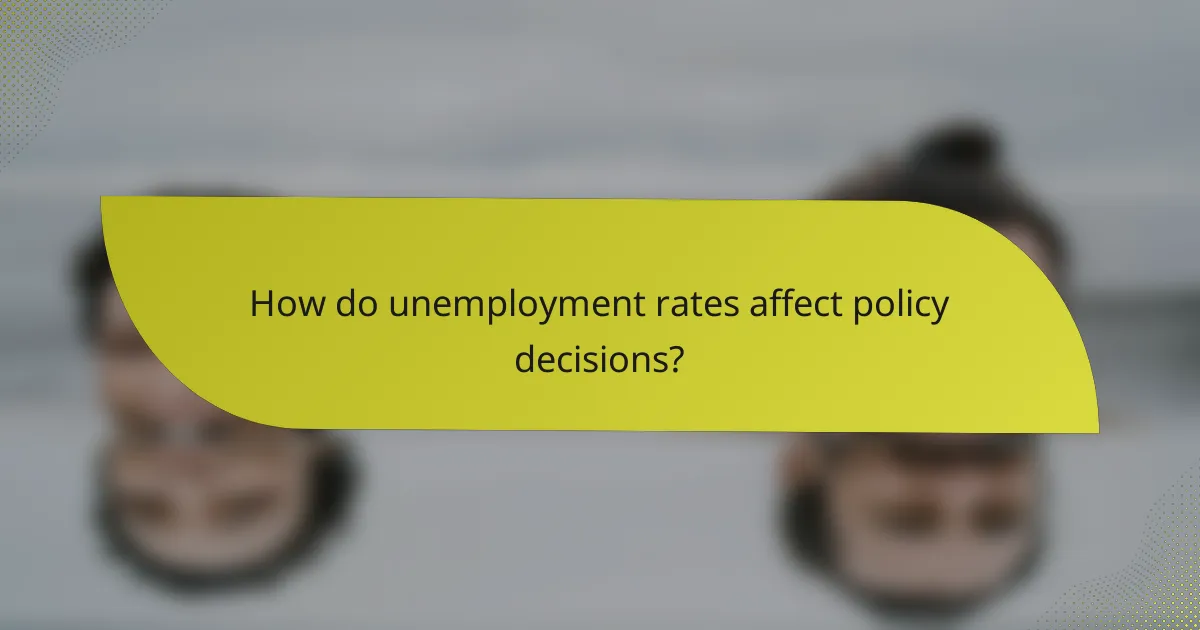
How do unemployment rates affect policy decisions?
Unemployment rates significantly influence policy decisions as governments often respond to rising joblessness with targeted measures. High unemployment typically prompts policymakers to implement strategies aimed at economic recovery and job creation to stabilize the workforce and maintain social order.
Focus on job creation initiatives
Governments prioritize job creation initiatives when unemployment rates rise, often through public works programs and incentives for businesses. These initiatives may include tax breaks for companies that hire unemployed workers or funding for infrastructure projects that create temporary jobs.
For example, during economic downturns, countries may invest in renewable energy projects or technology sectors to stimulate job growth. Such initiatives can also focus on upskilling the workforce, ensuring that workers are prepared for emerging job markets.
Changes in welfare and social security policies
High unemployment often leads to adjustments in welfare and social security policies to support those affected. Governments may expand unemployment benefits or introduce new social programs to assist individuals struggling to find work.
For instance, countries may increase the duration of unemployment benefits or provide additional support for job training programs. These changes aim to alleviate financial strain on families while encouraging re-employment through skill development and support services.
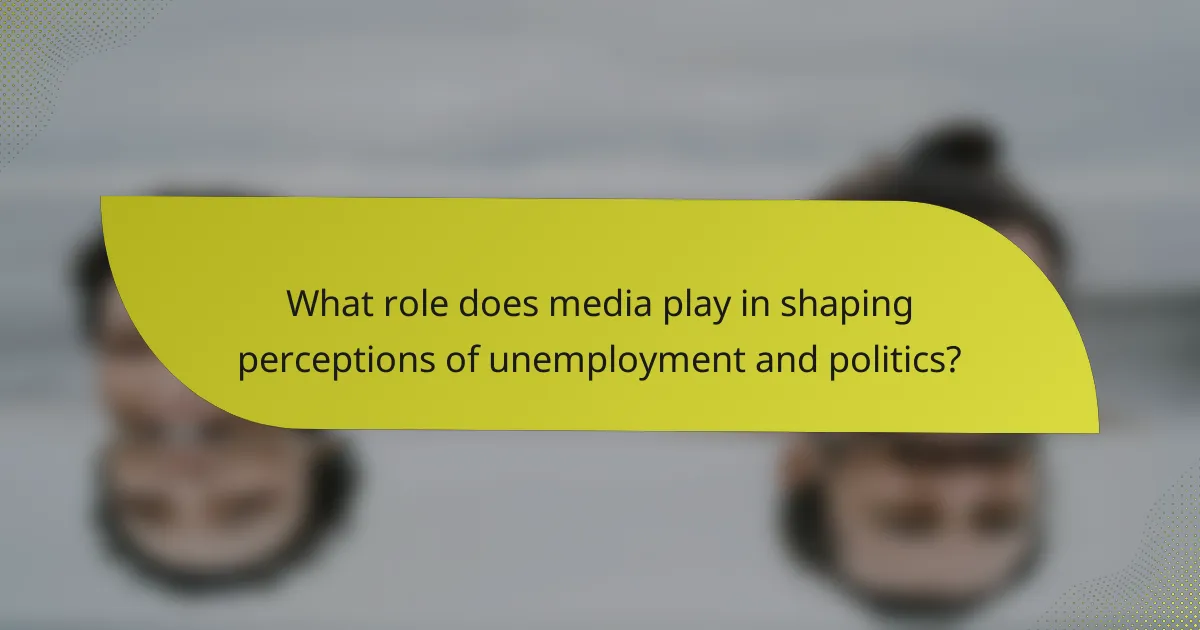
What role does media play in shaping perceptions of unemployment and politics?
Media plays a crucial role in shaping how unemployment is perceived and its political implications. Through various platforms, media outlets influence public understanding, framing unemployment not just as an economic issue but also as a catalyst for political movements.
Influence of news coverage on public opinion
News coverage significantly impacts public opinion regarding unemployment rates and their political consequences. When media emphasizes rising unemployment, it can create a sense of urgency and concern among the populace, often leading to increased political engagement.
For example, during economic downturns, negative news stories can amplify feelings of discontent, prompting citizens to seek change through political action. Conversely, positive coverage of job growth may lead to complacency, reducing the perceived need for political reform.
Social media’s role in mobilizing movements
Social media serves as a powerful tool for mobilizing political movements in response to unemployment. Platforms like Twitter and Facebook enable rapid dissemination of information, allowing individuals to organize protests and campaigns effectively.
Hashtags related to unemployment can unite voices across different demographics, fostering a collective identity and purpose. This digital mobilization often translates into real-world actions, such as rallies or petitions, which can influence political agendas and policies.
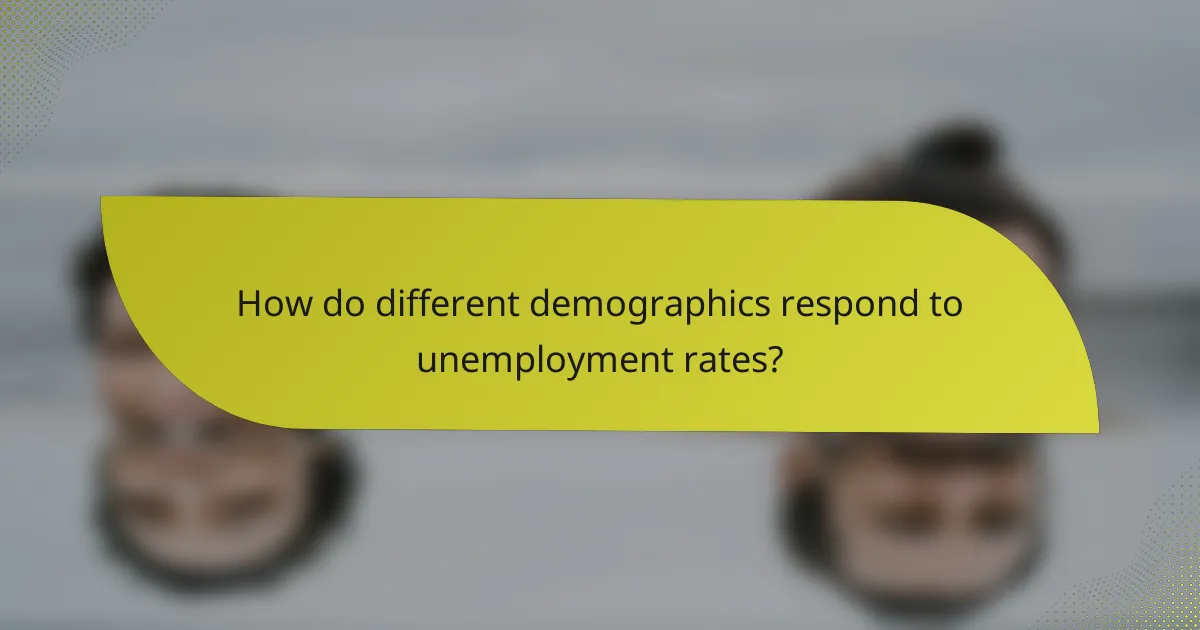
How do different demographics respond to unemployment rates?
Different demographics respond to unemployment rates in varied ways, often influenced by factors such as age, ethnicity, and socioeconomic status. These responses can shape political movements and influence voting behavior, as groups seek to address their unique challenges and advocate for change.
Impact on youth political engagement
Younger individuals typically demonstrate heightened political engagement during periods of high unemployment. This demographic often feels the direct impact of job scarcity, leading to increased activism and participation in movements advocating for job creation and educational opportunities.
For instance, youth-led organizations may mobilize around issues like student debt relief or minimum wage increases, reflecting their concerns over economic stability. Engaging in protests, social media campaigns, and voter registration drives are common strategies used to amplify their voices.
Responses from minority communities
Minority communities often experience disproportionately high unemployment rates, which can catalyze organized political responses. These groups may rally around issues such as systemic inequality and demand policies that promote equitable job opportunities and anti-discrimination measures.
For example, community organizations might focus on advocating for local hiring initiatives or workforce development programs tailored to their members’ needs. Additionally, the intersection of unemployment and social justice issues can lead to broader coalitions that address both economic and civil rights concerns.
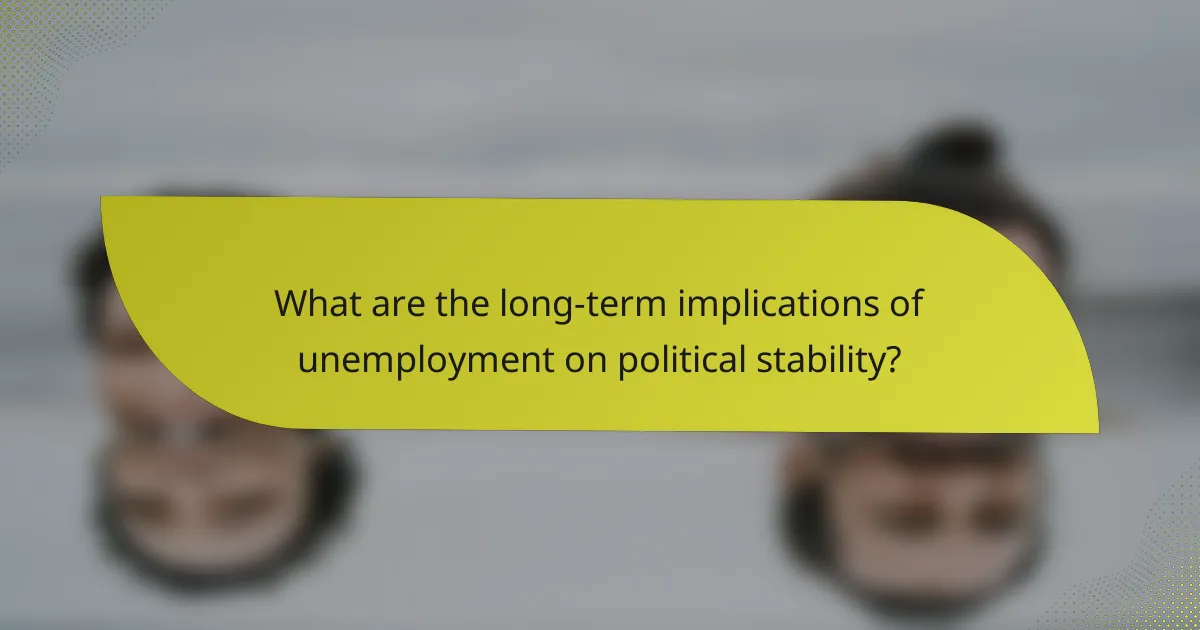
What are the long-term implications of unemployment on political stability?
Long-term unemployment can significantly undermine political stability by fostering discontent and eroding trust in government institutions. As joblessness persists, citizens may become increasingly frustrated, leading to shifts in political allegiances and the rise of extremist movements.
Potential for increased polarization
High unemployment rates often contribute to greater political polarization, as individuals may gravitate towards parties that promise radical solutions. This division can manifest in the form of ideological extremes, where moderate voices are drowned out by more radical factions.
For example, in countries experiencing prolonged economic downturns, such as Greece during its financial crisis, political parties on both the far-left and far-right gained traction by appealing to the frustrations of the unemployed. This polarization can create a hostile political environment, making compromise and collaboration increasingly difficult.
Risk of civil unrest
Elevated unemployment can lead to civil unrest, as disenfranchised citizens may take to the streets to express their grievances. When economic hardship is widespread, protests and demonstrations can escalate into violence, further destabilizing the political landscape.
Historical examples include the Arab Spring, where high unemployment rates among youth fueled widespread protests against established regimes. Governments facing such unrest must navigate the delicate balance between addressing economic issues and maintaining order, often leading to significant political changes or upheaval.

What emerging trends are shaping the future of unemployment and political movements?
Emerging trends such as the rise of remote work and the gig economy, along with the impact of automation, are significantly influencing unemployment rates and political movements. These factors are reshaping job markets and altering the dynamics of labor relations, which in turn affect political engagement and activism.
Rise of remote work and gig economy
The rise of remote work and the gig economy has transformed traditional employment structures, leading to increased flexibility but also job insecurity. Many workers now engage in freelance or contract work, which can result in fluctuating incomes and a lack of benefits typically associated with full-time positions.
This shift has prompted political movements advocating for better protections and rights for gig workers, including calls for minimum wage standards and access to healthcare. As more individuals participate in this economy, their collective experiences may drive political agendas focused on labor rights and economic stability.
Impact of automation on job markets
Automation is reshaping job markets by replacing routine tasks with technology, leading to job displacement in various sectors. Industries such as manufacturing and retail are particularly affected, with many positions becoming obsolete while new roles emerge that require different skill sets.
As automation continues to evolve, political movements may focus on retraining programs and policies aimed at supporting displaced workers. The challenge will be to balance technological advancement with the need for sustainable employment opportunities, ensuring that workers are not left behind in this transition.
